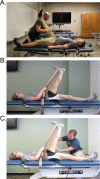Instrument-assisted soft tissue mobilization and proprioceptive neuromuscular facilitation techniques improve hamstring flexibility better than static stretching alone: a randomized clinical trial
- PMID: 30692839
- PMCID: PMC6338275
- DOI: 10.1080/10669817.2018.1475693
Instrument-assisted soft tissue mobilization and proprioceptive neuromuscular facilitation techniques improve hamstring flexibility better than static stretching alone: a randomized clinical trial
Abstract
Objectives: Tight hamstrings contribute to inefficiency of movement and increased risk for injury. Static stretching is the most common intervention for this problem, but the use of alternatives like instrument-assisted soft tissue mobilization (IASTM) and proprioceptive neuromuscular facilitation (PNF) is increasing among clinicians. This study examined two prospective studies with the common aim of demonstrating the effectiveness of IASTM or PNF over static stretching for improving hamstring tightness. Methods: Nondisabled adults were recruited on a university campus. IASTM study: N = 17 (11 males and 6 females). PNF study: N = 23 (7 males and 16 females). Hip flexion range of motion was measured with a passive straight leg raise (for IASTM) or active straight leg raise (for PNF) before and after stretching. Participants performed a self-static stretch on one leg and received the alternative intervention on the contralateral leg. The two studies were analyzed separately for reliability indices and significant differences between interventions. Results: Hip flexion measures showed good reliability in both studies (intraclass correlation coefficient = 0.97) with a minimal detectable change of <4.26. Both studies showed significant interactions between time and intervention (p < 0.05). Follow-up analyses revealed PNF and IASTM interventions resulted in greater increases in hip flexion range than static stretching. Discussion: These findings demonstrate the effectiveness of PNF and IASTM techniques over static stretching for hamstring flexibility. These interventions provide more efficient alternatives for improving flexibility in the clinic, allowing greater progress in a shorter period of time than an equivalent static stretching program. Level of Evidence: 1b.
Keywords: Flexibility; active straight leg raise; digital inclinometer; hip flexion; knee flexors; lower extremity; passive straight leg raise; range of motion.
Figures




References
-
- Moore KL, Dalley AF, Agur AM.. Clinically oriented anatomy. Lippincott Williams & Wilkins; Philadelphia, 2013.
-
- Chumanov ES, Schache AG, Heiderscheit BC, et al. Hamstrings are most susceptible to injury during the late swing phase of sprinting. Br. J. Sports Med.. 2012;46(2):90. - PubMed
-
- Sando JP, McCambridge TM.. Nontraumatic sports injuries to the lower extremity. Clin Pediatr Emerg Med. 2013;14(4):327–339.
-
- Willems TM, Cornelis JAM, De Deurwaerder LEP, et al. The effect of ankle muscle strength and flexibility on dolphin kick performance in competitive swimmers. Hum Mov Sci. 2014;36:167–176. - PubMed
Publication types
MeSH terms
LinkOut - more resources
Full Text Sources
Medical
